History of Rostov-on-Don
Foundation of Rostov-on-Don
Long before the foundation of Rostov-on-Don, the first Russian emperor Peter I wanted to build a fortress on the site of the present city to protect the southern borders of the Russian Empire from the raids of the Ottomans and Crimean Tatars. But because of the Treaty of the Pruth, which ended the Russo-Turkish War of 1710-1711, it became impossible as the treaty was a political victory for the Ottoman Empire.
By the decree of Empress Elizabeth Petrovna dated December 15, 1749, the Temernitskaya customs house was founded here, at the mouth of the Temernik River, on the right bank of the Don River in its lower reaches, about 46 kilometers from the mouth of the river, where it flows into the Sea of Azov. In the spring of 1750, a pier, a warehouse, a quarantine, and a garrison barracks were built at the customs.
In 1756, the international “Russian and Constantinople Trading Company” was opened here. Temernitsky port became the only Russian port in the south of the Russian Empire through which trade with the countries of the Black, Aegean and Mediterranean Seas was carried out.
In 1760-1761, the construction of the fortress began to protect the lower reaches of the Don. The garrison of the fortress numbered more than four thousand people. The fortress was originally named after Metropolitan Demetrius of Rostov and Yaroslavl (1652-1709) canonized by the Russian Orthodox Church.
More Historical Facts…
Over time, houses for merchants and clergymen, shops, taverns, a prison, and other buildings were built here. The port of Rostov quickly became known in Russia and abroad, attracting more and more Russian and foreign merchants. Foreign goods went from here to the depths of Russia: to Moscow, Smolensk, Kazan, Orenburg, Vyatka, and to numerous fairs.
The fortress had a large garrison, was armed with 238 guns and for half a century was used as a rear base for the Russian troops. The fortress of St. Demetrius of Rostov played a significant role during the Russian-Turkish wars of the second half of the 18th century. During the Russian-Turkish war of 1768-1774, it served as a base for the offensive against Azov.
Rostov-on-Don in the late 18th - 19th centuries
By the end of the 18th century, because of the annexation of the territory of the Crimean Khanate to Russia, the fortress lost its strategic importance, the fortifications were dismantled. In 1779, Catherine II allowed the Crimean Armenians to settle here. They founded the settlement of Nor-Nakhichevan to the east of the fortress. Today, it is the Proletarsky District of Rostov-on-Don.
The name of the fortress and the settlement subsequently changed: the fortress of St. Demetrius, the fortress of Demetrius of Rostov, the Rostov fortress, just Rostov, and finally, to distinguish it from the old Russian town of Rostov the Great located near Yaroslavl, Rostov-on-Don.
In 1811, Rostov received its coat of arms, which depicted a fortress tower, symbolizing the town’s past. After eliminating the danger from the Ottoman Empire and the development of the southern trade routes, Rostov-on-Don found itself in the center of the country’s foreign trade. In 1836, a new Rostov customs house was built, and in 10 years the trade turnover of the Rostov port increased by about 30 times.
By the middle of the 19th century, it became one of the largest export points for grain and iron in the Russian Empire. The rapid growth in freight traffic caused a strong impetus to the development of river shipping and shipbuilding. Rostov was famous for two fairs, some of the biggest in the country. Rostov also had the largest fish market in Russia.
In 1875, with the construction of the Rostov-Vladikavkaz railway, the opening of the first drawbridge over the Don and the first large railway station, Rostov-on-Don turned into one of Russia’s largest railway junctions. In 1887, it was included in the Don Cossack Host Oblast (an administrative-territorial unit populated mostly by Don Cossacks and governed under special conditions), which was the impetus for the further development of industry.
According to the 1897 census, 119,476 people lived in Rostov-on-Don. The following native languages were mentioned: Russian - 94,673, Jewish - 11,183, Ukrainian - 5,612, Polish - 1,444, Armenian - 1,182, German - 1,182, Tatar - 1,172.
Rostov-on-Don in the 20th century and beyond
During the Russian Civil War of 1918-1920, Rostov-on-Don played a prominent role as one of the centers of the anti-Bolshevik White movement. The Soviet period in the history of Rostov-on-Don began on February 11, 1920. In the late 1920s, active construction began in Rostov-on-Don. In 1926, the plant “Rostselmash”, a giant of the Soviet agricultural machine building, was founded.
On November 29, 1935, the country’s largest drama theater with an auditorium for 2,200 seats was opened in the city. The theater building was designed in the shape of a giant tractor. On September 13, 1937, Azov-Black Sea Krai was divided into Krasnodar Krai with the center in Krasnodar and Rostov Oblast with the center in Rostov-on-Don. In 1939, Rostov-on-Don was the 4th most populated city in Soviet Russia - 510 thousand people.
During World War II, German troops occupied Rostov-on-Don twice: in the fall of 1941 and in the summer of 1942. On November 20, 1941, the Germans entered the city for the first time. A week later, on November 28, Soviet troops recaptured the city during the Rostov offensive operation. The liberation of Rostov was the first significant victory of the Red Army in the initial period of the war.
Rostov-on-Don remained Soviet until July 1942, when, after the failure of the Red Army offensive near Kharkov, the German command launched an offensive in the Kuban and the Caucasus. On July 24, 1942, the 17th Army of the Wehrmacht entered Rostov-on-Don. On February 14, 1943, after the victory at Stalingrad, during the general retreat of the Wehrmacht in the southern sector of the Eastern Front, Rostov-on-Don was finally liberated from German troops.
The war caused great damage to Rostov-on-Don, about 12 thousand houses were destroyed. On August 9, 1945, a general plan for the restoration of the city was approved. It was included in the list of the 15 largest and oldest Russian cities to be rebuilt in the first place. By the early 1950s, it was almost completely done.
In the 1970s, the reconstruction of Rostselmash and other large enterprises of the city was carried out. As a result of mass housing construction, large residential areas Western and Northern were built. The area of the city’s housing stock more than doubled in three decades. In 1987, Rostov-on-Don became one of the cities of the USSR with a population of over one million.
After the collapse of the USSR, Rostov-on-Don became one of the largest business centers and the 10th most populous city in Russia. In 1999, its 250th anniversary was celebrated, a lot of architectural monuments were restored.
In 2000, Rostov-on-Don became the center of the Southern Federal District (about 11% of the total population of Russia). In 2008, it was awarded the honorary title “City of Military Glory”. In 2018, Rostov-on-Don hosted five matches of the FIFA World Cup.
Streets of Rostov-on-Don
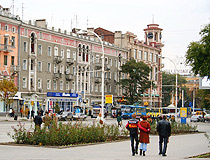
Architecture of Rostov-on-Don
Author: Pavel Chelombiev
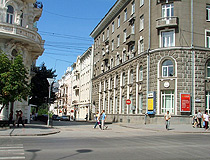
In the center of Rostov-on-Don
Author: Vadim Anokhin
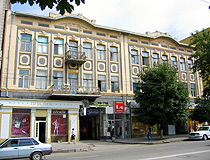
Rostov-on-Don architecture
Author: Ilya Gusev
Rostov-on-Don - Features
Rostov-on-Don is located in the southeastern part of the East European Plain. The city is mostly located on the right bank of the Don River, on the left bank there are some industrial enterprises, shopping and entertainment centers. The distance to the Azov Sea is about 46 km, to the Black Sea - 380 km, to Moscow - 1,130 km. Unofficially, Rostov-on-Don is called the “Gateway to the Caucasus” and the “southern capital of Russia”.
The climate in the city is temperate continental. Winters are mild and with little snow; the average January temperature is minus 3.0 degrees Celsius. Summers are hot, long and dry, with a predominance of sunny weather; the average July temperature is plus 23.4 degrees Celsius.
The historical coat of arms of Rostov-on-Don, adopted in 1811, depicts a tower symbolizing a barrier from the raids of neighboring peoples (the Crimean Tatars and Turks) and weapons of these peoples as war trophies. The City Day of Rostov-on-Don is celebrated on the third Sunday of September.
Rostov-on-Don is one of the largest economically developed cities in the south of Russia. The products of “Rostselmash” (agricultural machinery) cover more than 50% of the Russian market, “Don Tobacco” - 12%. “Rostvertol” is the only enterprise on the territory of the Russian Federation that produces helicopters for various purposes, “Yug Rusi” is known as the largest producer and exporter of sunflower oil.
This city is the largest transport hub in the Southern Federal District of Russia. Platov International Airport, commissioned in December 2017 for the 2018 FIFA World Cup, is located about 40 km from Rostov-on-Don and offers regular flights to Moscow, St. Petersburg, Astrakhan, Yekaterinburg, Nizhny Novgorod, Samara, Sochi, Dubai, Istanbul, and a number of other cities. Several federal and regional highways pass through Rostov-on-Don, including the M-4 “Don” highway, which runs along the outskirts of the eastern side of the city.
Too low traffic capacity of streets and lack of good transport interchanges plus a large traffic flow, especially during peak hours, are the main reasons for frequent traffic jams. Also, the problem of parking for personal vehicles is very acute, especially in the old part of the city, in the center. Cars parked near office buildings occupy a large area of the roadway, which also leads to the creation of traffic jams.
Many in Russia know the criminal nickname of this city: “Rostov - papa” meaning “Rostov - dad” (similar to the nickname of the city of Odessa in Ukraine - “Odessa - mama” meaning “Odessa - mom”). Rostov-on-Don and Odessa became the southern capitals of the criminal world during the late Russian Empire.
At the end of the 19th century - the beginning of the 20th century, a lot of criminals led a nomadic, vagrant lifestyle. Therefore, when they were detained without passports and asked about their parents, one could hear the answer: “Rostov is my dad, Odessa is my mom.” This is one of the versions of the origin of these nicknames. Today, Rostov-on-Don is not included in the list of cities with the highest crime rate in Russia.
The city has more than 800 objects of cultural heritage, including 470 architectural monuments, 55 archeological monuments, 106 monuments of monumental art and military glory. The historic center of Rostov is especially rich in monuments of architecture.
Rostov-on-Don is also one of the largest jazz centers in Russia. In the early 1980s, the country’s first “professor of jazz” Kim Nazaretov opened the department of pop-jazz music at the Rostov Conservatory.
Main Attractions of Rostov-on-Don
Bolshaya Sadovaya Street - one of the oldest and most beautiful streets in Rostov-on-Don, where a lot of city sights are located. Its length is about 4 km. Most of the buildings are old mansions where the families of local merchants and industrialists once lived. Numerous sculptures and monuments are installed on this street.
The Rostov City Hall (1899), an architectural monument of federal significance and one of the most beautiful buildings in the city, is located on this street (Bolshaya Sadovaya Street, 47). The two-story Margarita Chernova House, gifted to this famous actress of the 19th century by her rich admirer (Bolshaya Sadovaya Street, 27/47), can be considered a real gem of the street.
The main entrance to the Central City Park named after Maxim Gorky, the oldest park in the city, can also be found on this street. At the entrance there is a bronze statue of Vladimir Lenin on a granite pedestal.
Rostov Regional Museum of Local Lore - one of the largest museums in the south of Russia representing the nature, culture and history of the Rostov region. The most interesting exposition can be found in the hall “Treasures of the Don Burial Mounds” - about 2,000 gold and silver items of the 4th century BC - 8th century AD. Bolshaya Sadovaya Street, 79.
Embankment of the Don River. Named after the Russian admiral Fyodor Ushakov, it is the main resting place for locals and visitors of Rostov-on-Don. At any time of the day, you can ride a boat or motor ship here. For walking, there is a pedestrian zone about 2 km long with a lot of original sculptures and monuments. Another attraction of the embankment is the light and music fountain. All city holidays and festivals are held on the embankment.
Pushkinskaya Street - a very picturesque, wide, shady street that is perfect for walking at any time of the year. The street began to actively build up in the first decade of the 20th century. This part of the city was chosen by merchants and wealthy artisans. Most mansions are still in good condition. There are also cozy cafes and restaurants here.
Theater Square - the main square of Rostov-on-Don. The 65-meter-high “One Sky” Ferris wheel installed nearby is the largest one in the south of Russia. An excellent panorama of the city opens from its highest point. Other attractions include a huge building of the Maxim Gorky Drama Theater constructed in the shape of a tractor, a stele to the Soviet soldiers-liberators, a large fountain, the Administration Building of the North Caucasian Railway (a monument of public architecture of the early 20th century).
Underground passages decorated with mosaics - a unique monument of Soviet art created by master mosaicist Yuri Palshintsev in several underground passages at the intersections of the main city streets in 1979-1984. The best time to look at the mosaics and take photos is late in the evening, when passers-by are not in the way.
Cathedral of the Nativity of the Blessed Virgin Mary (1854-1860) - the main Orthodox church in Rostov-on-Don, one of the main architectural and historical monuments of its center. This five-domed church built in the Russian-Byzantine style resembles the Cathedral of Christ the Savior in Moscow. The height of the bell tower (1875-1887) is 75 meters. The cathedral is located next to the busiest part of the city center - the Central Market. Stanislavskogo Street, 58.
Surb Khach Church (1786-1792) - an Armenian church in Rostov-on-Don. Built by Armenian migrants from Crimea in memory of the monastery of the same name, it is the oldest preserved building of Rostov-on-Don. Bagramyana Street, 1.
Pictures of Rostov-on-Don
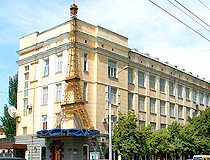
Eiffel Tower in Rostov-on-Don
Author: Stanislav Pierwszy
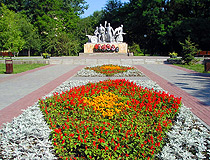
Flower beds and the monument to Soviet soldiers in Rostov-on-Don
Author: Stanislav Pierwszy
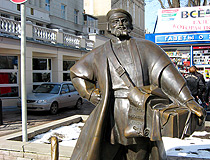
Monument to a merchant-peddler and his cat in Rostov-on-Don
Author: Eugeny Gromenko
Rostov Regional Museum of Fine Arts. The collection of the museum includes about 6,000 works of painting, graphics, sculpture, decorative and applied arts. The permanent exhibition presents old Russian art, Russian art of the 18th - early 20th centuries, foreign art of Western European masters and countries of the East, the collection of 20th century art. Pushkinskaya street, 115.
Museum of the North Caucasian Railroad. The collection of this open-air museum includes more than 50 steam, diesel, electric locomotives and wagons, as well as a variety of railway machinery and equipment. The length of the four museum tracks is 1,900 meters. Tsiolkovskogo Street, 73.
Botanical Garden of the Southern Federal University - a beautiful green oasis located in the northwestern part of Rostov-on-Don. Numerous trees, shrubs, rare flowers, and herbs are growing on an area of more than 160 hectares. In one place, examples of flora from Africa, Australia, Southeast Asia, North and South America are collected. The exhibition hall features a collection of exotic insects. Botanicheskiy Spusk Lane, 7.
Rostov Zoo - one of the largest zoos in Russia covering an area of 57 hectares. It is home to about 5 thousand animals of 400 species. A distinctive feature of this zoo is its extensive park area, which makes it a particularly popular recreation place among city residents. Zoologicheskaya Street, 3.
Abandoned Paramonov’s Warehouses - a huge warehouse complex built almost in the very center of the city in the middle of the 19th century. Despite its dilapidated state, this monument of industrial architecture is one of the favorite places of locals and tourists. Red-brick walls and water flowing from windows surrounded by greenery make this place mysterious and attractive. Nizhnebulvarnaya Street, 27.
Monument “Tachanka-Rostovchanka” - a monument in honor of the First Cavalry Army standing at the southern entrance to Rostov-on-Don. The tachanka is a spring cart with a machine gun attached to it. It is one of the main symbols of the Russian Civil War. The height of this very picturesque monumental sculptural composition is 15 meters.
Levberdon - an informal name for urban areas stretching along the left bank of the Don for almost 10 km. Almost all of this territory is occupied by free and paid beaches, walking areas, recreation centers, restaurants, summer cafes, clubs, and other entertainment establishments. This area also attracts fishing enthusiasts.
Don Military History Museum - an interesting museum located in the village of Nedvigovka, about 35 km west of Rostov-on-Don. The model of the old fortress is of great interest. In the open air and in hangars, one can see rare exhibits of military equipment, including tanks, armored vehicles, Red Cross vehicles, minefield clearing machines, various types of transport, artillery pieces of the Soviet Union, Germany, and the United States.


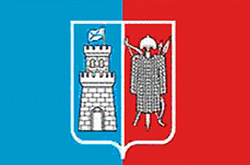
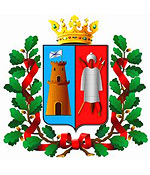
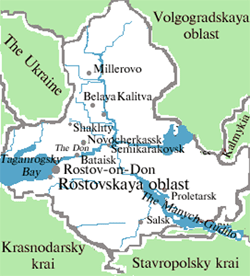






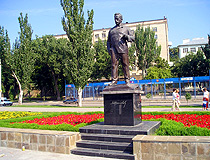
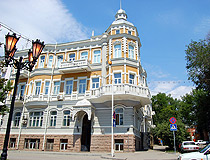

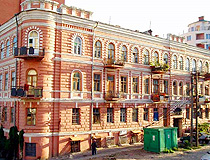
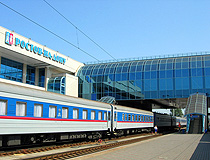
The comments of our visitors